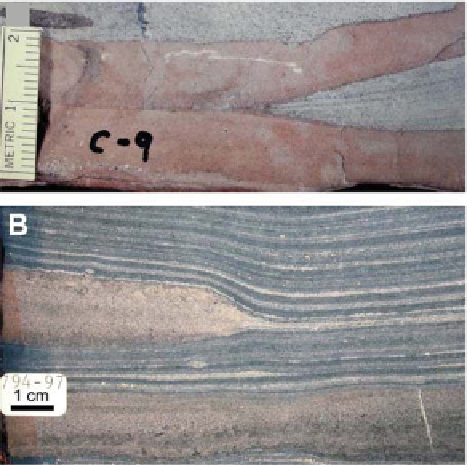Geology Reference
In-Depth Information
to small sea-level changes and coastal instability
may be more common in building a stratigraphic
record than presently appreciated.
(a)
SUBSURFACE DEPOSITION
Paradoxically, sedimentation events are com-
monly best preserved when sedimentation occurs
below the sediment surface rather than on top.
Storm sediment infi llings of deep excavating bur-
row networks of mud shrimp were documented
following Hurricane Kate in 1985 (Wanless
et al
.,
1988a). These infi llings ('tubular tempestites')
tend to be coarse, poorly sorted mixes of grains
moving near the bottom during storms. The fi ner
material left as a surface layer at the end of the
event will quickly be obliterated by bioturbation.
These coarse, storm-generated, burrow infi llings
preserve a record of storm-event sedimentation
and have forced reassessment of the depth of sedi-
mentary environments such as Palaeozoic mud
mounds (Tedesco & Wanless, 1989). These coarse
storm infi lls demonstrate that these mounds were
well above storm wave-base.
(b)
Fig. 5.
Examples of layering modifi ed by pervasive pressure
dissolution. In both, light layers are limestone and darker
layers are fi nely crystalline dolomite and insoluble grains.
(a) A limestone layer containing quartz sand pinches out
but the insoluble quartz continues as a traceable band
showing that this limestone layer was originally much
more extensive but has been lost by pressure dissolution.
Cambrian Conocheague Limestone, western Maryland,
USA; originally grainy limestone layers with quartz (storm
layers) and fi ne carbonate mud (now dolomitic) from lesser
events; deposited in shallow-marine waters. (b) Skeletal
and intraclastic limestone layer, containing radiolarians
and fi ne quartz sand thins through a zone of pervasive
pressure dissolution but the insoluble grains continue as a
markedly thinned layer. Ordovician distal slope limestone
and shale, Picadilly, Port au Port, Newfoundland, Canada.
Other light layers were also originally thicker distal turbid-
ite layers but have been completely thinned by pressure
dissolution.
DIAGENESIS AND LAYERING
Selective diagenesis (cementation, recrystalliza-
tion, dolomitization and pressure dissolution)
commonly accentuates subtle differences in pri-
mary layers that would not otherwise stand out.
In the Pleistocene Miami Limestone, for example,
the fi ner oolitic layers become better cemented
than the coarser layers during early meteoric
diagenesis. Although a minor grain-size differ-
ence (350 vs. 300 μm), the different textured lay-
ers become very distinct and may take different
pathways during later recrystallization and pres-
sure dissolution.
In the Cambro-Ordovician, shallow-marine 'rib-
bon limestones' have an alternation of limestone
and dolomitic limestone beds, from millimetres
to centimetres in thickness. These layers are com-
monly displayed on the weathered outcrop as
alternation of grey and tan (Fig. 5). Wanless (1979,
1982) offered evidence that this bedding is the
result of selective pervasive pressure dissolution
of the fi ner-grained beds with the dolomite form-
ing as a 'reactate' byproduct mineral during dis-
solution. Again, what may have begun as small
textural differences may become pronouncedly
different in form, composition and altered thick-
ness with diagenesis.
Pressure dissolution commonly accentuates
small initial differences or forms along the bound-
ary between two bed types (Logan & Semeniuk,
1976; Wanless, 1979, 1981), but it can also create
layering and fabric where there was none origin-
ally. Structural geologists commonly recognize
that 'spaced solution cleavage' is a fabric that
forms by pressure dissolution in rocks in response
to tectonic stresses. Cleavage is commonly at an
angle to primary stratifi cation because compres-
sive tectonic stress directions are usually not
vertical. The fabrics produced, spaced solution
cleavage, pencil cleavage and fl attened nodular
lenses, however, are very similar to that seen in

